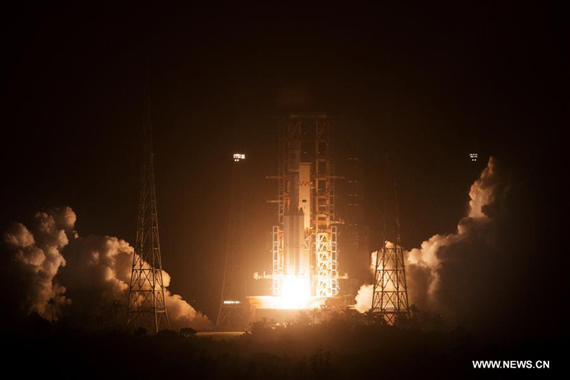
China's first cargo spacecraft Tianzhou-1, atop a Long March-7 Y2 carrier rocket, blasts off from Wenchang Space Launch Center in south China's Hainan province, April 20, 2017. (Xinhua/Ju Zhenhua)
China has taken another step toward its goal of putting a space station into orbit around 2022, by sending its first cargo spacecraft Tianzhou-1 into space on Thursday evening.
Atop a Long March-7 Y2 carrier rocket, Tianzhou-1 rose into the air from the Wenchang Space Launch Center in south China's Hainan Province at 7:41 p.m.
China declared the launch a success after it entered designated orbit minutes later.
The cargo ship will dock with the orbiting Tiangong-2 space lab where two Chinese astronauts spent 30 days in the country's longest-ever manned space mission, provide fuel and other supplies to the latter, as well as conduct space experiments before falling back to Earth.
If the Tianzhou-1 mission is successful, China will become the third country besides Russia and the United States to master the technique of refueling in space.
China aims to build a permanent space station that is expected to orbit for at least 10 years, and the debut of the cargo ship is important as it acts as a courier to help maintain the space station.
Without a cargo transportation system, the station would run out of power and basic necessities, causing it to return to Earth before the designated time.
"The Tianzhou-1 mission includes the breakthrough of in-orbit refueling and other key technology needed to build a space station, laying a foundation for future space station operations," said Bai Mingsheng, chief designer of the cargo ship.
THREE DOCKINGS
Measuring 10.6 meters long and boasting a maximum diameter of 3.35 meters, the Tianzhou-1 cargo ship has a maximum takeoff weight of 13.5 tonnes, and could carry over 6 tonnes of supplies.
Tianzhou-1 is larger and heavier than Tiangong-2, which is 10.4 meters in length and has a maximum diameter of 3.35 meters, weighing 8.6 tonnes.
Bai said that supplies loaded on the cargo spacecraft are nearly as heavy as the ship's own weight, exceeding the loading capacity of Russian cargo ships in active service.
Tianzhou-1 will dock with Tiangong-2 three times, said Bai. After the first docking, aerospace engineers will test the controlling ability of the cargo spacecraft over the two spacecraft.
The second docking will be conducted from a different direction, which aims to test the ability of the cargo ship to dock with the space station from different directions.
In the last docking, Tianzhou-1 will use fast-docking technology. Previously, it took China about two days to dock, while fast docking will take about six hours, according to Bai.
Refueling is conducted during docking, a process that is much more complicated than refueling vehicles on land.
The refueling procedure will take 29 steps and last for several days each time.
This means the Tianzhou-1 will stay in space for about six months. It will fall into a designated sea area after fulfilling its tasks.


















































